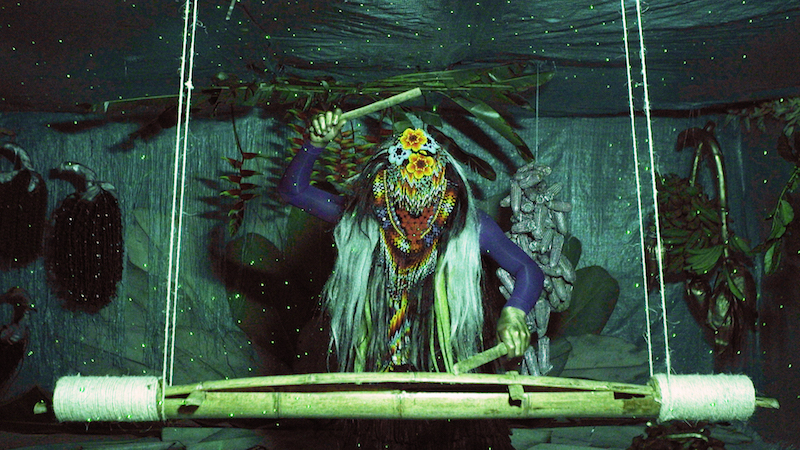by Mia Butter // Feb. 21, 2025
Through collaboration and commitment to an interdisciplinary practice, artist and DJ Natalia Escobar creates a nuanced body of work with Indigenous communities in Colombia, among them Las Traviesas. A group of trans indigenous women from the Emberá people, Las Traviesas navigate the coffee plantations located in the Andes Mountains, where they work as coffee harvesters. Developed over three years, ‘AWERA’ was brought into being by reflecting on Emberá cosmovision and cultural heritage while stepping away from white, western understandings of queerness.
Utilizing a wide range of disciplines—from film, music and beading, to printing, twerking and photography—a dialogue emerged through their interaction. In conversation with the artist, we discussed the deep symbolism rooted in ‘AWERA,’ the creation of sound worlds and bringing the work into national institutions, reclaiming space. The three-channel video, ‘TRAVIESAS,’ will be shown to a Berlin audience during an event hosted by Berlin Art Link at Studio IIII on February 27th.

Natalia Escobar: ‘TRAVIESAS,’ film still // Courtesy of the artist
Mia Butter: Your three-channel video ‘TRAVIESAS’ is part of a larger, multidisciplinary project titled ‘AWERA,’ created in collaboration with Las Traviesas. How did this project come to be?
Natalia Escobar: I met the girls in Santuario, Risaralda, in 2020. Zamanta, one of the community leaders, invited me to the coffee farm she was managing—about two hours from town, deep in the mountains. She lived there with Bella, Veronica and Yorladis, trans women from the Embera Katío and Embera Chamí communities who had left their reservations due to discrimination and violence. In Santuario, they found work as coffee pickers and, more importantly, they found each other.
At first, they thought I was a journalist and offered to give me interviews. As they shared their struggles and dreams, they told me: “We want to exist in Colombia.” I explained that I wasn’t a journalist and shared my work. They got really excited about the idea of collaborating on an audiovisual project.
We stayed in touch throughout the pandemic, imagining ways to work together. I reached out to Simon(e) Jaikiriuma Paetau, an artist and filmmaker I deeply admire, and shared their story. Together, we envisioned an artist residency—a space for creative exchange. By January 2021, we had secured funding and returned to make it happen.
We rented a farm to host the residency, AWERA—which means “the path to become a woman”—became a space for creative exchange, without a rigid plan. Since the girls worked as coffee pickers during the week, we met on weekends for workshops in Embera music, performance, beading, monotype printing, twerking and photography. The works emerged from shared experiences—ancestral futures, dream retellings and imagination exercises—expanding and challenging traditional narratives. It was inspiring to witness their efforts in building a community on their own terms, breaking free from patriarchal constraints and shaping new forms of kinship, self-governance and identity. Their aspirations for political and juridical recognition, as well as their desire to redefine what it means to be an Embera woman, guided us in shaping a project that could strengthen their community bonds.
Las Traviesas have often been misrepresented, exposed and violated by biased media narratives that fail to understand trans-Embera experiences or consider the community’s perspective. It was essential for us to break that cycle—to honor their power, beauty and resilience while collaboratively envisioning an attainable utopia.

Natalia Escobar: ‘TRAVIESAS,’ installation view at Kasseler DokFest, 2023 // Photo by Nicolas Wefers
MB: The title of your work references the word “traviesa,” which carries several meanings. From “oblique” to more sexual connotations, to minor coffee harvests. What about these references made this title feel right for the work?
NE: The title of the work ‘TRAVIESAS’ references a name the community originally gave themselves when they first arrived in Santuario about nine years ago. At that time, they had little contact with paisas (mestizos) and were not yet familiar with the term “transgender.” Instead, they identified as Traviesas, a word that carries layered meanings.
There is a direct link to their lived experiences. When they arrived in the region, they sought work harvesting la traviesa, the term for the minor coffee harvest that takes place roughly six months after the main one. The overlap between their self-identification and the name of this harvest felt profoundly symbolic.
These processes of self-representation, shaped by local understandings of gender and sexuality, became a central theme of the project. The work seeks to capture the beauty of their journey—one of transformation, resilience and self-representation. The installation is a glimpse into this voyage, a dance through different dimensions, moving towards emancipation. ‘TRAVIESAS’ encapsulated this spirit perfectly.
Today, with increased contact with the western world, they identify as transgender women and have renamed their community Las Mariposas del Café (The Coffee Butterflies), as they feel Las Traviesas no longer fully represents them. However, I still find Las Traviesas so poetic. It speaks to a time of transition and self-discovery, making it a meaningful title for the installation.

Natalia Escobar: ‘TRAVIESAS,’ film still // Courtesy of the artist
MB: Sound plays a significant role in your practice–as a DJ and an interdisciplinary artist. Can you elaborate on the function of sound in this piece?
NE: Sound is central to the installation’s multidimensional experience. During the residency, we held music workshops with Embera Chami musician, Rubiel Aricapa, exploring ancestral instruments and their histories. Together, we built a Carangano—a percussive instrument made from guadua (bamboo). Rubiel also introduced us to traditional Embera instruments like the Charrasca, Tambora and Zaú maracas, which we recorded.
The sonic environment of the area was rich and intense—at night, the air was filled with a chorus of insects, frogs and other unidentifiable sounds. I captured these through field recordings, along with interviews, spoken-word recordings in the Embera language, traditional songs and new songs the girls created and shared. Their love for carrilera music also became an important layer in the project’s sound.
Back in Berlin, I collaborated with Konrad Black to produce the sound design and music, weaving these recordings into a cross-border aesthetic. The sound of ‘TRAVIESAS’ blends acoustic and digital elements—analog recordings meet hyper-digital compositions, while field recordings, WhatsApp voice messages, conversations and mythical Embera songs merge with electronic textures and melodies. Traditional Embera instruments coexist with electronic soundscapes, not in opposition, but as part of an expanded, speculative sound world—one that challenges colonial hierarchies of music and disrupts eurocentric notions of “folklore.”

Natalia Escobar: ‘TRAVIESAS,’ installation view at Kasseler DokFest, 2023 // Photo by Nicolas Wefers
MB: Early last year, you had an exhibition at the National Museum of Colombia where you showed ‘AWERA.’ What did it mean to you, to bring this work reflecting on colonial structures and queerness from a rural context into a national institution in Bogotá?
NE: Exhibiting ‘AWERA’ at the National Museum of Colombia was deeply symbolic. Historically, trans-Indigenous people have been excluded from such spaces, with little to no representation in institutional records. For Las Traviesas, who once told me, “We want to exist in Colombia,” this exhibition marked a powerful step toward visibility and recognition. It was an act of reclaiming space, bringing diverse cultures, identities and spirits into an institution that had previously overlooked them.
Beyond showcasing the artworks, we spent a week at the museum with 13 members of the community, continuing our collaborative workshops. These workshops helped bridge cultural and linguistic divides, promote skill-sharing and establish new alliances beyond the community. Through creative expressions and cultural activities, our program sought to amplify their voices, cultivate spaces for mutual understanding and build solidarity. However, these efforts also revealed the material realities that queer and Indigenous communities face daily, from logistical constraints to institutional resistance. These challenges underscored the complexity of addressing systemic inequality while also providing opportunities for dialogue, reflection and learning.
The exhibition featured a range of media, including film, photography, monotypes, selfies and behind-the-scenes videos. These works originated from the co-creation laboratory in the museum’s Panoptical room and earlier multimedia workshops in Santuario in 2021. The exhibition invited an intimate dialogue between diverse origins and imaginations, reflecting Las Traviesas’ aspirations to strengthen their trans-Indigenous community. ‘AWERA’ underscored the importance of unexpected collaborations and new, unpredictable kinships that transcend conventional genealogical, ethnocentric and anthropocentric relationships.
Las Traviesas played a central role in arranging the exhibition layout, offering insights into their creative process to museum educators and communicators. A roundtable brought together eight Indigenous leaders (Inga, Wayuu, Nasa) to discuss self-governance and recognition in urban settings. They addressed Indigenous migration, traditional governance and legal precedents for establishing cabildos in Bogotá. The conversation highlighted the importance of Las Traviesas embracing both their trans and Indigenous identities while navigating legal and social challenges. They also tackled internal conflicts, particularly homophobia and transphobia, underscoring the ongoing struggle for broader acceptance.
More than an exhibition, ‘AWERA’ created a space for learning, empowerment and visibility. By occupying the museum, forging new alliances and asserting their presence, Las Traviesas took a crucial step toward recognition and self-determination.
Artist Info
Click here to donate to Las Traviesas: Educational And Medical Needs for Estefania and Bella
Exhibition Info
Studio IIII
‘Berlin Art Link presents Natalia Escobar’
Exhibition & Party: Thursday, Feb. 27; 8pm; RSVP here
Potsdamer Straße 96, 10785 Berlin, click here for map



















